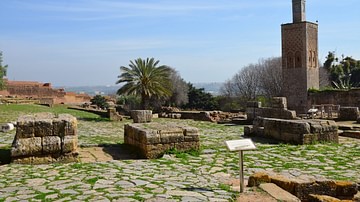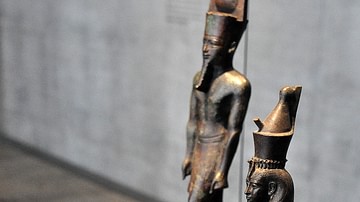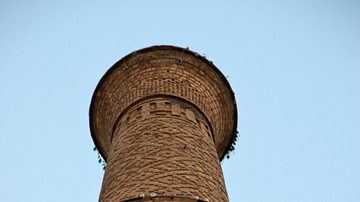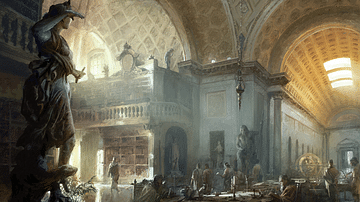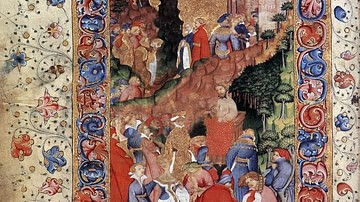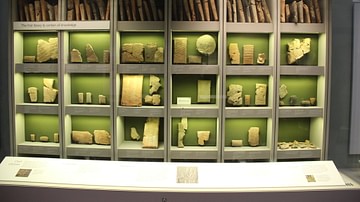Fatima Al-Fihri (c. 800-880) was a Muslim woman, scholar and philanthropist who is credited with founding the world’s oldest, continuously running university during the 9th century: the University of Al-Qarawiyyin, located in Fez in Morocco.
Born in Tunisia in the city of Qairouan (Kairouan), after which she named the mosque and educational institution that would later become a leading centre of intellectual exchange, Fatima Al-Fihri migrated with her family to the city of Fez, located in northern Morocco, as a young adult. During the 9th century the city of Fez grew into a thriving cosmopolitan centre of commerce, culture, scholarship and trade. It reached its apex as an intellectual, cultural and trade epicentre during the 13-14th centuries, while under the rule of the Berber Marinid Dynasty (1248-1465).
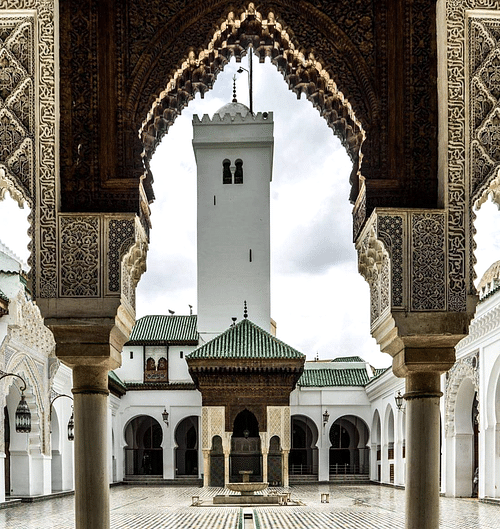
According to the historical chronical Rawd al-Qirtas (The Garden of Paper) written during the 14th century by Ibn Abi Zar (d. 1315), Fatima’s father, Muhammad al-Fihri al-Qayrawwani, was a successful Arab merchant, who hailed from the tribe of Quraysh (a famous Bedouin tribe that used to live in Mecca). Although not born into riches, Fatima and her sister Mariam inherited a vast fortune when her father, brother and husband all died within a short time span.
Al-Qarawiyyin Mosque (Jami' al-Qarawiyyin)
Uninterested in commerce and the accumulation of wealth, both sisters chose to invest instead in sadaqah – the Islamic idea of pious charity. Both used their inheritance to build mosques and schools in Fez. Mariam built the Al-Andalus Mosque, while Fatima built the Al- Qarawiyyin Mosque complex, which included a madrasa; madrasa is an Arabic word that refers to any kind of educational institution –both secular and religious, elementary or secondary. In the Muslim world, mosques often became community centres that were utilised not only for religious purposes, but also for social gatherings, charitable services, educational classrooms, market places, and even political rallies.
Fatima first purchased a plot of prime real estate, near the Suq al-'Attarin or Spice Market, in the centre of the city of Fez. On the first day of Ramadan in 859 she, along with her sister, laid the foundation for the mosque and adjacent madrasa – perhaps unaware at that time that it would become the world’s first degree granting university; or perhaps she knew it all along. Fatima named the mosque after her birthplace, the city of Qairouan in Tunisa. Qarawiyyin means "belonging to the people of Qairouan."
The architectural design and layout of Al-Qarawiyyin Mosque was ambitious to say the least. Fatima employed the most skilled engineers and craftsmen of the times, and used materials of the highest quality. Following classical Islamic architectural layout for a mosque complex, Al-Qarawiyyin Mosque included a large ceramic-tiled courtyard that housed a fountain basin for the faithful to perform their ablutions before prayer. A customary arcade both frames the courtyard and ventilates the interior spaces, which lead to the large prayer hall. In addition to the tall minaret from which a muezzin would call the believers to prayer, the mosque also housed a library and separate praying quarters for women. The mosque also housed a library and separate praying quarters for women.
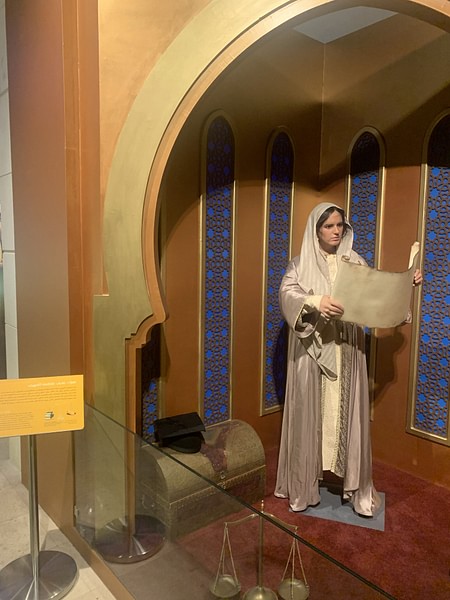
Historians believe it took about two years, from 857 to 859, to construct the main buildings of the Al- Qarawiyyin Mosque, under the patronage of Fatima, who it is said, oversaw every detail of architecture and craftsmanship herself. Between 1134 and 1143, the Almoravid ruler, Sultan 'Ali ben Yusuf further expanded the mosque complex to its current size. Sa'did Sultan 'Abdallah ibn al-Shaikh added additional fountains and blue tiles to the courtyard between 1606 and 1623.
Some scholars suggest that some teaching and instruction probably took place at al-Qarawiyyin Mosque from a very early period or from its beginning. Major mosques in the early Islamic period were typically multi-functional buildings where teaching and education took place alongside other religious and civic activities. From its very early days, the mosque housed a neighbourhood madrasa. Over time, the Qarawiyyin madrasa developed into an institution of higher learning that attracted famous scholars from all over the Muslim world, and later even from medieval Europe.
Becoming a University
Although it is difficult to pinpoint exactly when Qarawiyyin became an important place of higher learning, many historical accounts and travelogues mention the quality, breadth and scope of its teaching. Halaqas – meaning circles of learning referring to the organisation of madrasa classrooms where students sat in a semi-circle around their teacher, are mentioned from both the 10th and 12th centuries. The Moroccan historian and ambassador Abdelhadi Tazi (1921-2015) suggests that the earliest written record of teaching Al-Qarawiyyin is from 1141; while his fellow historian and countryman Mohammed Al-Manouni mentions that the mosque became a formal place of higher education, that granted qualifying certificates to scholars, between 1040-1147, during Almoravid rule. As such, most historians agree that Al-Qarawiyyin was the world’s first-degree granting institution, as well as a leading centre of scientific debate and scholarship that is a university. It set the standard that would become the reference point for institutions of higher learning the world over, drawing visitors, students and lecturers from all over the world.
Most scholars, however, consider that Al-Qarawiyyin reached its zenith as a centre of intellectual excellence – both in the secular sciences and philosophy and in religious jurisprudence (fiqh) and theology (qalam) during the 13th and 14th centuries. It was during this time that its research and scholarship were at their most ambitious, drawing scholars from all over the Muslim world including Central Asia, South Asia, the Levant, and the Hejaz.
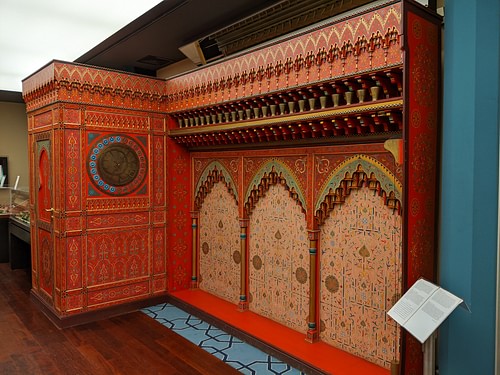
The university's curriculum included but was not limited to Quranic exegesis (tafsir), Islamic jurisprudence, algebra, astronomy, botany, cartography and geography, grammar, history, literature, logic, mathematics, medicine, philosophy, physics and a host of foreign languages including Greek and Latin. Notably, the mosque complex also thrived as a spiritual centre where Islamic mysticism (Sufism) and gnosis (irfan) thrived.
Traditionally, the student body was comprised of boys and men, however girls and women who were interested in learning were provided with spaces in a special gallery (riwaq) that overlooked the students’ circle and from where they could listen to the discussion and write questions on paper to be sent to the teacher and on showing an interest would receive individual tuition. Fatima al-Fihri is said to have studied Islamic Jurisprudence and mathematics at her own institution.
Decline
By the 18th century, the curriculum at Al-Qarawiyyin had dwindled in scope, focusing increasingly on the traditional Islamic curriculum and Arab language and literature. Even Islamic philosophy, Quranic exegesis and mysticism had been eschewed in favour of a stricter and more orthodox and didactic approach. By 1789, the 'Alawi sultan Muhammad ibn Abdallah, had already issued strict limitations on the university’s programmes, discontinuing classes in astronomy and medicine while slowly steering the faculty away (it dwindled from 426 members to 266 with only about 100 still teaching classes) from more secular scholarship on logic and philosophy, even banning key Sufi teachings. Sultan Abd al-Rahman followed in his footsteps in 1845, adjudicating further “reforms” to the curriculum.
Al-Qarawiyyin’s famous library, which scholars came from around the world to consult, also suffered neglect resulting in a large portion of the collection being lost. From thousands of books and manuscripts on diverse disciplines and in a host of languages, the collection at the beginning of the 20th century numbered around 1,600 manuscripts and 400 printed books.
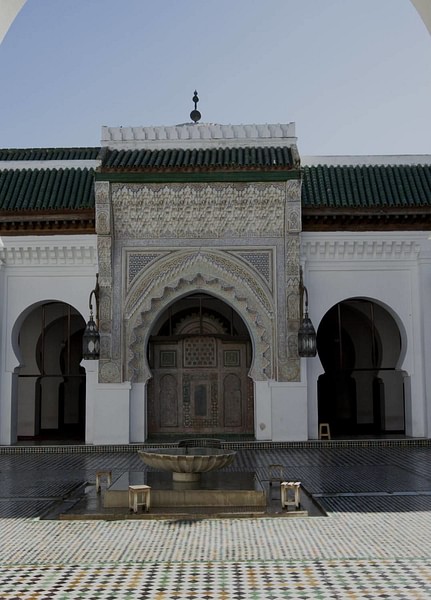
The Library
Currently, among the most notable manuscripts in the library collections are volumes from the famous Al-Muwatta collection of hadiths (sayings of the Prophet Muhammed) by Imam Malik ibn Anas (711-795) that is inscribed with ink on gazelle parchment, the Al-Sirah al-Nabawiyyah (Biography of the Prophet) by Ibn Ishaq (704-768), Ibn Khaldun’s (1332-1406) historical opus the Muqaddimah as well as the original manuscript of his book Al-‘Ibar. There is also a famous Quran that was donated to the library in 1602 by the Saadi Sultan Ahmad al-Mansur.
In 2012, the Al-Qarawiyyin Library was rehabilitated and curated by well-known Moroccan architect Aziza Chaouni who discovered Fatima al-Fihri’s own manuscript collections as well as a copy of her diploma from Al-Qarawiyyin in fiqh and mathematics. Since the completion of renovations, the library has been open to the public and includes “exhibition room for manuscripts, a small museum to showcase the history of the Qarawiyine complex, a laboratory for the treatment of old books, and a cafe.” (azizachaouniprojects.com).
Famous Scholars
Many of the scholars who studied at Al-Qarawiyyin have had a strong impact on the intellectual and academic history of the Muslim world. Among these are Al-Biruni (973-1048), a polymath who made major contributions to mathematics, physics, astronomy, and geography; Al-Idrisi (1100-1165) the cartographer whose maps were eagerly studied by Renaissance geographers; Ibn Tufayl (d. 1185) who wrote the world’s first science fiction novel as well as a treatise on self-led learning called Hayy ibn Yaqzan; Ibn Rushd (1126-1198) translator and commentator of Aristotle known in Europe as Averroes; the Jewish scholar and mystic Maimonides (1138-1204) who would have a profound influence on Jewish philosophy and theology; the astronomer Al-Bitruji (d.1204) known in Europe as Alpetragius; Ibn Al-Arabi (1165-1240) the Sufi mystic, philosopher and poet; the historian Ibn Khaldun (1332-1406) whose work laid the foundations for modern sociology, history political economy; and Hassan al-Wazzan (c. 1494 - c. 1554) aka Leo Africanus who wrote the first definitive book on Africa in Latin for a European readership, The Description of Africa.
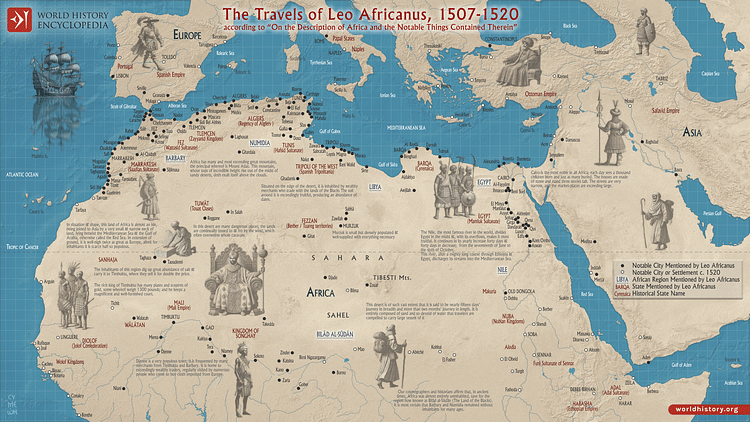
European scholars began to read the work produced at Al-Qarawiyyin in Latin translation, making the university highly esteemed among certain circles. Christian monks and scholars began to visit the madrasa. These visiting scholars included the Flemish Deist and grammarian Nicolas Cleynaerts (1495-1542) who died at the Alhambra. The famous Pope, Sylvester II (999-1003), who was born Gerbert of Auvergne (930-1003), brought with him the use of the zero and Arabic numerals after studying at Al-Qarawiyyin. Later, during the 16th century, the Arabist and translator Jacob van Golius (1596 –1667) would also study at the university.
Oldest University in the World
Places of higher learning of course existed all over the world long before the 9th century, however Al-Qarawiyyin University is noted as the world’s oldest continuously operating university by UNESCO and Guinness World Records, amongst others. The world’s second oldest known university that is still operating was founded in the Italian city of Bologna 230 years later, that is the University of Bologna.
All the same, certain mediaeval historians considered the university (from Latin universitas) to be an institution of higher learning that was specifically Christian and European. Therefore, they hold that the earliest universities are all located in Western Europe, naming the University of Paris and the University of Bologna as the oldest universities. These same sources consider Al-Qarawiyyin to have been a madrasa – that is, an institution of higher education teaching Islamic jurisprudence and law, with only a passing interest in the sciences, mathematics, physics and so on. They argue that universities were only founded outside of Western Europe as a consequence of modernisation programmes carried out by colonial and post-colonial regimes. However, the Italian historian Yahya Pallavicini counters this narrative by contending that the model of the university was not found in Europe until the 12th century, but existed throughout the Muslim world from the founding of Al-Qarawiyyin in the 9th century until at least the early years of European colonialism.

Modern Naming
The Arabic letter Qāf which functions as a voiced sound without an equivalent transliteration in Latin script – the “awiyyi” triphthong which is difficult to pronounce, as well as the French colonization of Morocco have produced a varied to different Latin script transliterations and spellings of the university's name, including Al Quaraouiyine and Al-Karaouine in French orthographic style. The anglicised rendering of Al-Qarawiyyin has now become standard.
Becoming a State University
By 1912, when Morocco became a French protectorate, Al-Qarawiyyin was already in decline, both as a centre of Islamic learning and as a secular university, becoming instead more of a place of higher education for employees in the then sultan’s administration. Under French rule, the university saw structural reform between 1914 and 1947. Nevertheless, the curriculum was still steered towards a conservative reading of Islamic religious education. Simultaneously, or perhaps because of this, the student body declined, and the Moroccan classes who could afford it studied instead at newly established colleges and universities that followed the Western European model and adopted a similar curriculum, with the language of instruction being French rather than Arabic.
It was in 1947 that Al-Qarawayyin became part of the state administered education system, and in 1963, following independence, it became an officially state-run university under the Ministry of Education. The newly established state University of Al-Qarawiyyin now housed four new faculties and adopted a modern curriculum and textbooks along with founding a college for training professional teachers. Its new name was now “The University of Al-Qarawiyyin”. After 1975, the university reverted to a curriculum of Islamic religious studies and the more secular “general studies” courses moved to the new Sidi Mohamed Ben Abdellah University. In 1988, King Hassan II (r. 1961-99) re-established the teaching of the traditional Islamic sciences including law, theology and jurisprudence.
In June 2015, a royal decree declared the university as a public institution devoted to higher education and scientific research, with its own legislature ensuring financial, educational and scientific/programmatic independence. Today, the university’s most sought after degrees are in Arabic languages and literature, Islamic studies, and Moroccan culture and history. The student body is made up of people from all over North and West Africa as well as Francophone students interested in the history of the Maghreb. During the modern period, women have been able to attend the university and graduate with a degree since as early as the 1930s. Adjacent to the university, the mosque complex founded by Fatima al-Fihri preserves its place as the Jami’ Masjid or main Friday mosque and community centre.


